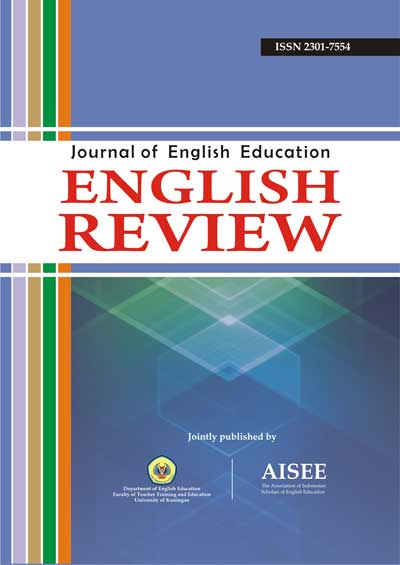DIRECTIVE SPEECH ACTS REALIZATION OF INDONESIAN EFL TEACHER
Abstract
Abstract: This research examines the types and functions of directive speech act performed by an Indonesian EFL teacher in one senior high school in Kuningan, Indonesia. This study uses qualitative method. The data of this research were taken from the video transcription which contains directives spoken by the EFL teacher and analyzed based on Kreidler’s (1998) theory. The findings show that there are three types of directives used by the teacher. They are commands, requests, and suggestions. The most frequent type of directives performed is commands with 233 occurrences (94.8%). It was also found that there are five functions seized by the directives, they are elicitation, instruction, advice, threat, and attention-getter. The most frequent function of directives used is elicitation with 108 occurrences (44%). From the findings, it is concluded that the using of commands shows teacher’s dominance. Yet, this type of directives is not easily understood by the students. Therefore, it is suggested that the teacher should use other types of directives more, such as requests and suggestions, to encourage students’ participation.
Keywords: pragmatics, speech act, directive speech act.Â
References
Amalsaleh, E., Yamini, H. & Yarmohammadi, Y. (2004). Directives used in university classrooms. Journal of Literature and Language 5 (1) p. 1-27. Retrieved January 28, 2014 from: www.ensani.ir/storage/Files/20120506112631-5138-96.pdf
Austin, J. (1962). How to do things with words. Cambridge: Cambridge University Press.
Brown, H. D. (2001). Teaching by principles: An interactive approach to language pedagogy (2nd ed.).White Plains, NY: Longman.
Creswell, J.W. (2009). Research design: Qualitative, quantitative, and mixed methods approaches (3rd ed.). Thousand Oaks, California: Sage Publications, Inc.
Hornby, A. S. (2003). Oxford advanced learner’s dictionary of current English. Oxford: Oxford University Press.
Kreidler, C. W. (1998). Introducing English semantics. London: Routledge.
Merdana, Seken, K., Putra, N.A.J. (2013). An analysis of speech acts produced by elementary school teachers and students to facilitate teaching and learning at SDN 10 Pringgasela East Lombok. e-Journal Program Pascasarjana Universitas Pendidikan Ganesha Program Studi Pendidikan Bahasa Inggris 1. Retrieved July 5, 2014 from:
pasca.undiksha.ac.id/e-journal/index.php/jpbi/article/download/.../508
Searle, J. (1969). Speech act: An essay in the philosophy of language. Cambridge: Cambridge University Press.
Wray, A., Trott, K., Bloomer, A. (1998). Projects in linguistics. New York: Oxford University Press.
All articles published in English Review: Journal of English Education (ERJEE) are licensed under the Creative Commons Attribution 4.0 International License (CC BY 4.0).
Copyright Ownership
Authors retain the copyright of their articles and grant ERJEE the right of first publication. The journal is granted a non-exclusive license to publish, reproduce, and distribute the article in any format, medium, or platform, provided that proper credit is given to the original authors.
License Terms – CC BY 4.0
Under the Creative Commons Attribution 4.0 International License, others are free to:
- Share — copy and redistribute the material in any medium or format
- Adapt — remix, transform, and build upon the material for any purpose, even commercially
As long as they:
- Provide appropriate credit to the original author(s) and source
- Provide a link to the license (https://creativecommons.org/licenses/by/4.0/)
- Indicate if any changes were made
There are no restrictions on the reuse, reproduction, or adaptation of published articles as long as attribution is properly given.
Author Warranties
By submitting a manuscript to ERJEE, authors confirm that:
- The work is original and does not infringe any existing copyright.
- The manuscript has not been previously published and is not under consideration elsewhere.
- All sources and references are appropriately acknowledged.
- Necessary permissions have been obtained for any copyrighted materials used.










